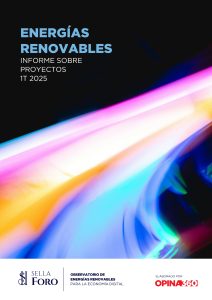April 16, 2025
-
The geographic distribution of energy generation will be key for the green reindustrialization process: Are renewables located where they need to be?
-
A strategic national and regional planning approach is essential, one that actively links the development of these energy hubs with reindustrialization policies.
-
Regions like Asturias, where industrial electricity consumption accounts for 65.8% of the total, have not recorded any renewable projects either authorized or in the public information phase during the last period.
-
Juan Francisco Caro, director of Opina 360, believes there is a certain slowdown in the volume of power granted construction permits, and that in order to meet ecological transition targets, this trend must not intensify over the year.
Last week, we explored in our article a key question raised in 2023 by economist Ricardo Hausmann: How will the transition to clean energy sources reshape the geography and structure of industrial production in the future? As Hausmann points out, the history of industrial location has been closely tied to the availability and nature of energy.
In light of this premise, for Spanish industry to undertake an effective decarbonization, access to green energy is a non-negotiable factor. The first-quarter 2025 report on renewable energy projects from Foro Sella’s Renewable Energy Observatory, compiled by Opina 360, reveals that administrative construction permits were granted for 143 renewable energy projects, amounting to a total capacity of 3,291 MW. This substantial injection of clean energy is undoubtedly a step forward—but the real question is whether this capacity is being deployed strategically to meet the actual needs of Spain’s industrial fabric.
Clean Energy Hubs as Industrial Magnets
Following Hausmann’s logic, the autonomous communities leading in renewable project authorizations and development—such as Castilla-La Mancha, Aragón, and Castilla y León—could position themselves as new industrial attraction hubs. In 2025 alone, these regions concentrate the highest authorized renewable capacity in the country: 1,109.7 MW in Castilla-La Mancha, 549.9 MW in Aragón, and 542.6 MW in Castilla y León. Moreover, in these regions, industrial electricity consumption accounts for 46.5%, 43.9%, and 45.4% of total demand respectively, according to an industrial electricity consumption analysis by Opina 360 for Foro Industria y Energía—highlighting a relevant production base.
The availability of clean energy—potentially at more competitive prices—could become a key factor in the location of new industries or the expansion of existing ones. To unlock this potential, strategic planning at both national and regional levels is essential, actively linking the development of these energy hubs with reindustrialization policies, offering incentives and enabling the connection between supply and demand for green energy.
Are “Green Plugs” Being Built Where They Are Most Needed?
Spain’s energy transition faces a key geographic challenge: the distribution of renewable energy resources. The geographic allocation of these resources will be critical for green reindustrialization. Are renewables located where they need to be?
The authorization process raises the question of whether renewable projects are being strategically located to meet the real needs of the most energy-intensive industrial centers. For instance, regions like Asturias—where industrial electricity consumption represents 65.8% of the total—have not registered any renewable projects either authorized or in the public information phase during the latest period. This lack of investment could lead to increased reliance on external or conventional sources, negatively impacting competitiveness due to price fluctuations or tighter regulatory demands. Asturias, home to industries such as steel production, risks compromising its transition unless local deployment of clean energy is accelerated. Similarly, Catalonia—which contributes 21.7% of Spain’s national industrial GDP—shows modest progress in renewable projects under review (128.5 MW), which could affect its industrial competitiveness in the future.
We must reconsider how electricity generation should be distributed to be as efficient as possible, aligning the location of renewable projects with the specific demands of industrial areas. Are we enabling the creation of “green plugs” precisely where factories need them to boost their competitiveness and sustainability—or are we generating an abundance of renewable energy in areas geographically distant from industrial consumption centers? The answer could determine not only the success of the energy transition, but also the country’s ability to balance industrial growth with sustainability. Without a clear strategy that links generation to consumption, we risk triggering regional imbalances that could hinder both decarbonization and reindustrialization.
Could a Slowdown in Authorizations Stall Green Industrial Ambitions?
Regarding the evolution of authorizations, Juan Francisco Caro, director of Opina 360, notes: “We’ve been observing a certain slowdown in the volume of power with construction permits. In this first quarter, 791 megawatts less were authorized compared to the previous quarter and 1,685 less than a year ago.” Caro adds: “This may be a result of the effort made by administrations in the third quarter of last year to prevent the expiration of many projects. But to meet ecological transition targets, it’s crucial that this trend doesn’t worsen over the course of the year.”
If this downward trend in authorizations continues, it could generate uncertainty, affect the timelines of industries seeking to switch to renewable energy sources, and—long-term—seriously compromise their competitiveness in an increasingly demanding international decarbonization context.
The development of new “green plugs” represents a unique opportunity to reindustrialize Spain under a sustainable and competitive model. However, to fully harness this potential, it is necessary to address the geographic mismatch between renewable generation and industrial demand, and to reverse the slowdown trend in authorizations.
The success of this transition will not depend solely on achieving quantitative renewable power targets, but also on the strategic coherence with which these resources are deployed to meet the real needs of the industrial sector. Only then will the new “green plugs” power a reindustrialization that is sustainable, competitive, and territorially balanced.


